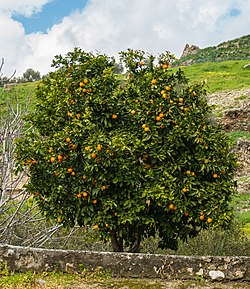Domestication
Mandarins appear to have been domesticated at least twice, in the north and south Nanling Mountains, derived from separate wild subspecies. Wild mandarins are still found there, including Daoxian mandarines (sometimes given the species name Citrus daoxianensis) as well as some members of the group traditionally called 'Mangshan wild mandarins', a generic grouping for the wild mandarin-like fruit of the Mangshan area that includes both true mandarins (mangshanyeju, [11] the southern subspecies) and the genetically distinct and only distantly-related Mangshanyegan. The wild mandarins were found free of the introgressed pomelo (C. maxima) DNA found in domestic mandarins. Still, they did appear to have small amounts (~1.8%) of introgression from the ichang papeda, which grows wild in the same region. [12]
The Nanling Mountains are home to northern and southern genetic clusters of domestic mandarins that have similar levels of sugars in the fruit compared to their wild relatives but appreciably (in some almost 90-fold) lower levels of citric acid. The clusters display different patterns of pomelo introgression, have different deduced historical population histories, and are most closely related to distinct wild mandarins, suggesting two independent domestications in the north and south. All tested domesticated cultivars belong to one of these two genetic clusters, with varieties such as Nanfengmiju, Kishu, and Satsuma from the northern domestication event producing larger, redder fruit, while varieties such as Willowleaf, Dancy, Sunki, Cleopatra, King, and Ponkan belong to the smaller, yellower-fruited southern cluster. [12]
Taxonomy
The Tanaka classification system divided domestic mandarins and similar fruit into numerous species, giving distinct names to cultivars such as willowleaf mandarins (C. deliciosa), satsumas (C. unshiu), tangerines (C. tangerina). Under the Swingle system, all these are considered to be varieties of a single species, Citrus reticulata. [13] Hodgson represented them as several subgroups: common (C. reticulata), Satsuma, King (C. nobilis), Mediterranean (willowleaf), small-fruited (C. indica, C. tachibana and C. reshni), and mandarin hybrids. [14] In the genomic-based species taxonomy of Ollitrault et al., only pure wild type mandarins would fall under C. reticulata, while the pomelo admixture found in the majority of mandarins would cause them to be classified as varieties of the hybrid bitter orange, C. aurantium. [15]
Genetic analysis is consistent with continental mandarins representing a single species, varying due to hybridization. [8] An island species, Citrus ryukyuensis that diverged 2 to 3 million years ago when cut off by rising sea levels, was found on Okinawa Island. Its hybridization with the mainland species has produced unique island cultivars in Japan and Taiwan, such as the Tachibana orange [11] the Shekwasha, [11] and Nanfengmiju. [16] They have some pomelo DNA, like all domesticated mandarins. [12] Northern and southern domesticates contain different pomelo contributions. [12] An 'acidic' group including Sunki and Cleopatra mandarins likewise contain small regions of introgressed pomelo DNA; they are too sour to eat, but are widely used as rootstock and grown for juice. [13] [8] Another group, including some tangerines, satsuma, and king mandarins, show more pomelo contribution. [8] Hybrid mandarins thus fall on a continuum of increasing pomelo contribution with clementines, sweet and sour oranges, and grapefruit. [10] [17] [8]







